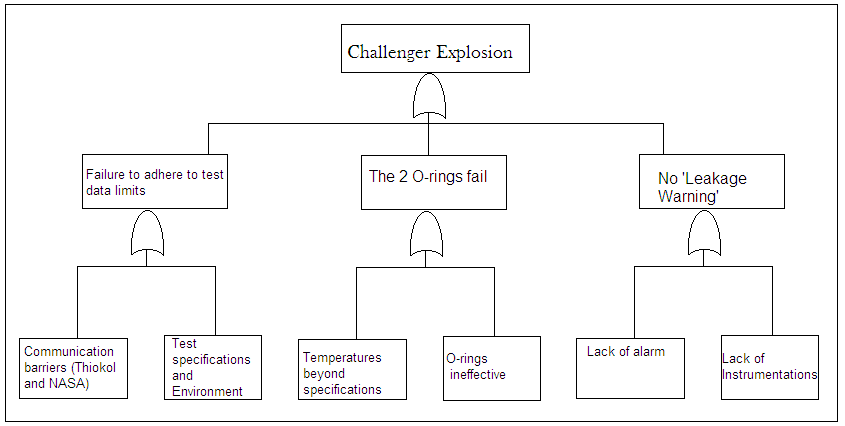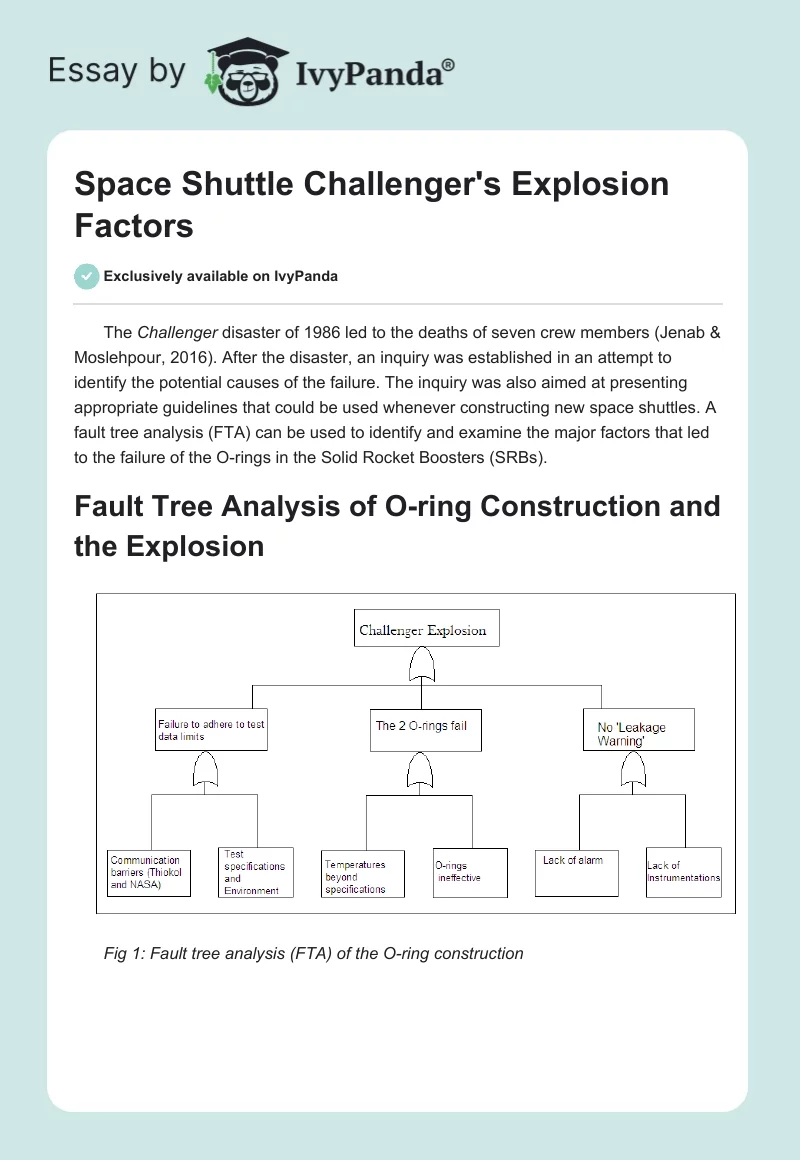The Challenger disaster of 1986 led to the deaths of seven crew members (Jenab & Moslehpour, 2016). After the disaster, an inquiry was established in an attempt to identify the potential causes of the failure. The inquiry was also aimed at presenting appropriate guidelines that could be used whenever constructing new space shuttles. A fault tree analysis (FTA) can be used to identify and examine the major factors that led to the failure of the O-rings in the Solid Rocket Boosters (SRBs).
Fault Tree Analysis of O-ring Construction and the Explosion

Analysis of the FTA
The Fault Tree Analysis (FTA) model can be described using the Boolean algebra. This is usually represented using the symbol (+) and is equivalent to the OR-gate. The Boolean equation is Q=A+B. This means that events A or B (or both) must occur for disaster Q to take place. That being the case, the Challenger disaster took place because of several factors. The above FTA model shows clearly that the explosion was caused by three major factors.
Such issues contributed (wholly or partly) to the failure of the O-rings in the Solid Rocket Boosters (SRBs). For instance, the tree analysis shows clearly that “the temperatures at the launch site and the communication barriers between Thiokol Engineers and NASA led to failure to adhere to test data limits” (Jenab & Moslehpour, 2016, p. 403). The other problem was caused by the failure of the O-rings. This failure was caused by the defective nature of the O-rings and existing temperature variations (Jenab & Moslehpour, 2016). The O-rings could not perform effectively at lower temperatures. The shuttle lacked effective alarm systems to report failures (Jenab & Moslehpour, 2016). These three contributing factors led to the explosion of the Challenger.
Summary of Risks Observed
The above Fault Tree Analysis (FTA) of the O-ring construction shows critical issues that must have been considered before launching the Challenger. The failure of the O-rings led to the explosion of the space shuttle after 73 seconds. The first issue was associated with the construction of the O-rings. The O-rings in the Solid Rocket Boosters (SRBs) were constructed in such a way that “they could close tightly due to the forces produced during ignition” (Jenab & Moslehpour, 2016, p. 404). A phenomenon known as joint rotation occurred during the launch process. The occurrence of this phenomenon forced combustion gases to escape through the safety O-rings. The joints failed due to increased erosion of gases.
The FTA can also be treated as a powerful risk assessment matrix. The matrix indicates that the shuttle did not have effective instrumentation to send signals after the O-rings failed. This fact explains why the crew could not cancel the launch after combustion gases escaped though the failed O-rings. The members of the crew were not warned about the leakage (Donovan & Green, 2003).
The third issue notable from this FTA is that NASA failed to adhere to existing test data limits. This is true because the shuttle was launched at a time when room temperatures exceeded those recorded during various test missions. This issue emerged because of poor communication between NASA and the engineers responsible for constructing the SRBs (Jenab & Moslehpour, 2016). The involved parties failed to monitor the critical weather conditions recorded at the launch site. Nonetheless, NASA decided to launch the space shuttle despite the existing concerns.
Ways to Mitigate the Risks
Several measures might have been undertaken to mitigate the risks identified above. To begin with, the failure of the O-rings shows conclusively that they were unable to seal gases completely after ignition. The two O-rings used to separate various chambers failed. This event allowed gases to escape. The use of three O-rings could have improved the effectiveness of the SRBs. The three O-rings would have sustained the gases and eventually prevent the disaster (Hall, 2003). This fact explains why every future space shuttle was equipped with SRBs containing three O-rings in every combustion chamber.
The issue of communication should have been taken seriously throughout the pre-launch period. The teams should have carefully analyzed test data and flow of different information. The space shuttle was launched at reduced temperatures compared to those specified by Thiokol Engineers (Jenab & Moslehpour, 2016). This disaster should have been avoided by focusing on this critical information regarding the performance of the O-rings.
The involved parties should not have launched the shuttle. Technicalities should have been identified and communicated to every member in the team. This approach would have played a positive role towards averting the disaster (Donovan & Green, 2003).
Future shuttles should be equipped with effective warning systems and corrective devices. Such systems can inform the crew members about the performance of every critical element in the space shuttle (Hall, 2003). The engineers and technicians on the ground should also be informed about the performance of such elements. These lessons should therefore be taken seriously whenever designing and launching space shuttles in the future.
Reference List
Donovan, A., & Green, R. (2003). Setup for Failure: The Colombia Disaster. Teaching Ethics, 1(1), 69-76.
Hall, J. (2003). Columbia and Challenger: Organizational Failure at NASA. Space Policy, 19(1), 239-247.
Jenab, K., & Moslehpour, S. (2016). Failure Analysis: Case Study Challenger SRB Field Joint. International Journal of Engineering and Technology, 8(6), 401-405.


